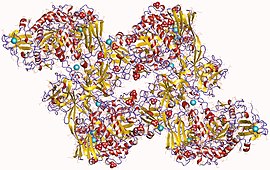| Pullulanase | |||||||||
|---|---|---|---|---|---|---|---|---|---|
 Debranching enzyme homotetramer, Klebsiella oxytoca | |||||||||
| Identifiers | |||||||||
| EC no. | 3.2.1.41 | ||||||||
| CAS no. | 9075-68-7 | ||||||||
| Databases | |||||||||
| IntEnz | IntEnz view | ||||||||
| BRENDA | BRENDA entry | ||||||||
| ExPASy | NiceZyme view | ||||||||
| KEGG | KEGG entry | ||||||||
| MetaCyc | metabolic pathway | ||||||||
| PRIAM | profile | ||||||||
| PDB structures | RCSB PDB PDBe PDBsum | ||||||||
| |||||||||
Pullulanase ( EC 3.2.1.41, limit dextrinase, amylopectin 6-glucanohydrolase, bacterial debranching enzyme, debranching enzyme, α-dextrin endo-1,6-α-glucosidase, R-enzyme, pullulan α-1,6-glucanohydrolase) is a specific kind of glucanase, an amylolytic exoenzyme, that degrades pullulan. [1] [2] [3] It is produced as an extracellular, cell surface-anchored lipoprotein by Gram-negative bacteria of the genus Klebsiella. Type I pullulanases specifically attack α-1,6 linkages, while type II pullulanases are also able to hydrolyse α-1,4 linkages. It is also produced by some other bacteria and archaea. Pullulanase is used as a processing aid in grain processing biotechnology (production of ethanol and sweeteners).
Pullulanase is also known as pullulan-6-glucanohydrolase (Debranching enzyme). Its substrate, pullulan, is regarded as a chain of maltotriose units linked by α-1,6- glycosidic bonds. Pullulanase will hydrolytically cleave pullulan (α-glucan polysaccharides).
Pullulanase enzyme in the food industry
In the food industry, pullulanase works well as an ingredient. Pullulan can be applied directly to foods as a protective glaze or edible film due to its ability to form films. It can be used as a spice and flavoring agent for micro-encapsulation. [4] It is used in mayonnaise to maintain consistency and quality. It is additionally used in low-calorie food formulations as a starch replacement.
Pullulanase can be used to convert starches in grains into fermentable sugars, which yeast can use to produce alcohol during fermentation.
References
- ^ Lee EY, Whelan WJ (1972). "Glycogen and starch debranching enzymes". In Boyer PD (ed.). The Enzymes. Vol. 5 (3rd ed.). New York: Academic Press. pp. 191–234.
- ^ Bender H, Wallenfels K (1966). "Pullulanase (an amylopectin and glycogen debranching enzyme) from Aerobacter aerogenes". Methods Enzymol. Methods in Enzymology. 8: 555–559. doi: 10.1016/0076-6879(66)08100-X. ISBN 9780121818081.
- ^ Manners DJ (1997). "Observations on the specificity and nomenclature of starch debranching enzymes". J. Appl. Glycosci. 44: 83–85.
- ^ Yatmaz E, Turhan (1995). "Pullulan production by fermentation and usage in the food industry". GIDA-Journal of Food. 2: 95–102.
External links
- pullulanase at the U.S. National Library of Medicine Medical Subject Headings (MeSH)
| Pullulanase | |||||||||
|---|---|---|---|---|---|---|---|---|---|
 Debranching enzyme homotetramer, Klebsiella oxytoca | |||||||||
| Identifiers | |||||||||
| EC no. | 3.2.1.41 | ||||||||
| CAS no. | 9075-68-7 | ||||||||
| Databases | |||||||||
| IntEnz | IntEnz view | ||||||||
| BRENDA | BRENDA entry | ||||||||
| ExPASy | NiceZyme view | ||||||||
| KEGG | KEGG entry | ||||||||
| MetaCyc | metabolic pathway | ||||||||
| PRIAM | profile | ||||||||
| PDB structures | RCSB PDB PDBe PDBsum | ||||||||
| |||||||||
Pullulanase ( EC 3.2.1.41, limit dextrinase, amylopectin 6-glucanohydrolase, bacterial debranching enzyme, debranching enzyme, α-dextrin endo-1,6-α-glucosidase, R-enzyme, pullulan α-1,6-glucanohydrolase) is a specific kind of glucanase, an amylolytic exoenzyme, that degrades pullulan. [1] [2] [3] It is produced as an extracellular, cell surface-anchored lipoprotein by Gram-negative bacteria of the genus Klebsiella. Type I pullulanases specifically attack α-1,6 linkages, while type II pullulanases are also able to hydrolyse α-1,4 linkages. It is also produced by some other bacteria and archaea. Pullulanase is used as a processing aid in grain processing biotechnology (production of ethanol and sweeteners).
Pullulanase is also known as pullulan-6-glucanohydrolase (Debranching enzyme). Its substrate, pullulan, is regarded as a chain of maltotriose units linked by α-1,6- glycosidic bonds. Pullulanase will hydrolytically cleave pullulan (α-glucan polysaccharides).
Pullulanase enzyme in the food industry
In the food industry, pullulanase works well as an ingredient. Pullulan can be applied directly to foods as a protective glaze or edible film due to its ability to form films. It can be used as a spice and flavoring agent for micro-encapsulation. [4] It is used in mayonnaise to maintain consistency and quality. It is additionally used in low-calorie food formulations as a starch replacement.
Pullulanase can be used to convert starches in grains into fermentable sugars, which yeast can use to produce alcohol during fermentation.
References
- ^ Lee EY, Whelan WJ (1972). "Glycogen and starch debranching enzymes". In Boyer PD (ed.). The Enzymes. Vol. 5 (3rd ed.). New York: Academic Press. pp. 191–234.
- ^ Bender H, Wallenfels K (1966). "Pullulanase (an amylopectin and glycogen debranching enzyme) from Aerobacter aerogenes". Methods Enzymol. Methods in Enzymology. 8: 555–559. doi: 10.1016/0076-6879(66)08100-X. ISBN 9780121818081.
- ^ Manners DJ (1997). "Observations on the specificity and nomenclature of starch debranching enzymes". J. Appl. Glycosci. 44: 83–85.
- ^ Yatmaz E, Turhan (1995). "Pullulan production by fermentation and usage in the food industry". GIDA-Journal of Food. 2: 95–102.
External links
- pullulanase at the U.S. National Library of Medicine Medical Subject Headings (MeSH)